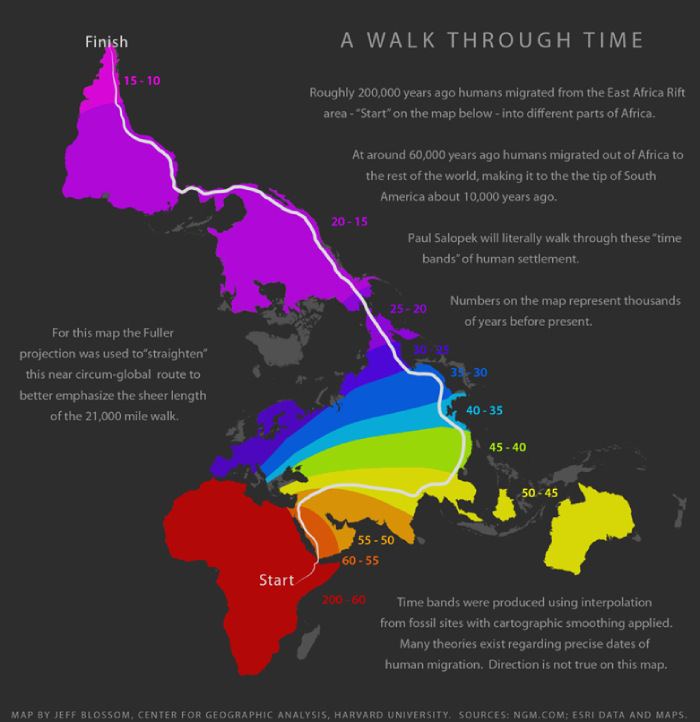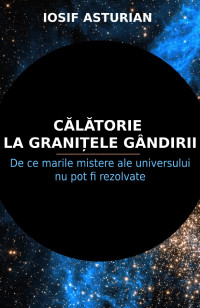
Harta migraţiei omului pe Terra, de la părăsirea Africii acum 600 mii de ani. Clic pe hartă pentru rezoluţia maximă
1. Lui James Watson, laureat al premiului Nobel pentru descoperirea structurii de spirală dublă a moleculei de ADN, i-au fost retrase toate distincţiile de către laboratorul unde era afiliat pentru afirmații reprobabile referitoare la rasă
2. Asteroidul 2019 AG3 a trecut azi pe lângă Terra la o distanţă de doar 4,9 milioane de kilometri
[Potrivit estimărilor calculate de ingineri, Asteroid AG 3 are un diametru cuprins între 64 şi 140 de metri. Asteroizii ce măsoară 140 de metri în diametre sunt incluşi în categoria PHA (Potentially Hazardous Asteroids/ Asteroizi Potenţial Periculoşi).]
3. ”Praf de stele” artificial obţinut în laboratoarele Universității Alexandru Ioan Cuza
[Praful creat în laborator, analog celui din spațiu, va permite comunității științifice să înțeleagă cum evoluează materia din spațiu și ce se întâmplă cu ea când este radiată sau se află în calea vreunei comete. Astfel de studii pot avea loc doar în laborator, cu ajutorul produșilor artificiali. Altfel, dacă cercetătorii s-ar limita să observe la ce se întâmplă în spațiu, cele câteva miligrame obținute săptămânal la Iași ar avea nevoie de câteva sute de milioane de ani pentru a se forma natural.]
4. Întârzierea bugetului de stat pe 2019 afectează grav sistemul naţional de cercetare
[Finanţările proiectelor obţinute prin competiţie nu se pot derula pe baza legii bugetului din anul anterior.]
5. Cât de departe putem călători?
[Să presupunem că omenirea devine o civilizație de tip 3, nu este exterminată de extratereștri și dezvoltă tehnologia necesară pentru călătoriile interstelare. În acest scenariu, în cel mai bun caz, cât de departe am putea ajunge? Am putea explora doar Grupul Local. Este cea mai mare structură din care omenirea va face parte. Deși Grupul Local este uriaș, el reprezintă doar 0.00000000001% din universul observabil.]
6. Inside Finland’s plan to train its population in artificial intelligence
[Originally started as a free-access university course, Finland's "1 percent" AI scheme is now being rolled out nationally with the support of private companies and the government. For Helsinki, there is also a clear economic incentive to training large numbers of Finns in the basics of AI: Doing so may allow Finland to stay competitive amid ever growing competition between China and the United States, and in the aftermath of the rapid decline of Nokia, the national mobile champion that has fallen on hard times.]
7. When you look up, how far back in time do you see?
[The Sun is about 150 million km away, so we see it as it was about 8 minutes ago. Even our nearest planetary neighbours, Venus and Mars, are tens of millions of kilometres away, so we see them as they were minutes ago.]
8. Cel mai puternic ceas inteligent pe care nu trebuie să-l încarci vreodată
[PowerWatch 2 se bazează pe un generator termoelectric care produce curent de la căldura pielii, dar are în plus şi celule fotovoltaice, care aduc un surplus de energie. PowerWatch 2 va costa 499 de dolari.]
9. Physicists Built a Machine That Breaks the Normal Rules of Light
[Physicists have built a ring in which pulses of light whip circles around each other and the normal rules that govern light's behavior no longer apply.]
10. What is computer vision?
[Some experts believe that true computer vision can only be achieved when we crack the code of general AI, artificial intelligence that has the abstract and commonsense capabilities of the human mind.]
11. Acupuncture is just a placebo
[Acupuncture is an extremely popular form of complementary alternative medicine (CAM) that has even worked its way into many “integrative” hospitals. It is also fiercely defended by its believers. Unfortunately, it is not well defended by actual evidence, so I want to talk about that evidence and explain why acupuncture is a placebo.]
12. Phosphorus: 350 years after its discovery, this vital element is running out
[Supplies of phosphate rock – the only major phosphorus ore – are limited. So much so that phosphorus has been listed among the “endangered elements” where there is a risk to future supply. The problem is that the phosphorus used as fertiliser ends up dissolved in rivers and oceans as soluble phosphate, eventually becoming sediment. Currently there is no economically viable way of recovering it, and scientists predict a shortage within about 30 to 40 years.]
